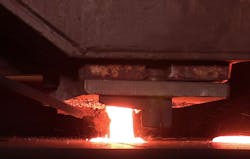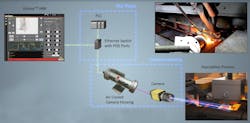Monitoring Inoculation for Process and Product Quality
Inoculation is the process of adding controlled amounts of specialized silicon alloys to liquid iron during pouring to improve the metallurgical and mechanical properties of castings. Verifying proper inoculation is critical to achieving that outcome, and in most automated pouring processes the operators controlling the pouring can check the operation of the system, but cannot verify the accuracy of the actual inoculation process. Inductotherm Corp.’s Visinoc™ system monitors the inoculation process accuracy by using vision to improve operational quality and reliability.
The Visinoc™ system is a vision-based inoculation monitoring and verification package that analyzes the feeding of inoculant particles into the iron pour stream. In addition, the system also checks that the inoculant discharge tube is properly aligned with the pour stream. It uses a smart vision camera to perform the analysis and process the raw data with on-board technology. The refined data is sent to a PLC where the inoculant particles are counted and compared to preset levels to determine whether the metal has been properly inoculated.
Stand-alone or integrated designs
The Visinoc™ system can be packaged as a stand-alone system or it can be integrated with Inductotherm’s Visipour® P³® (Predictive Pour Performance) pouring control technology. Since the system looks only at the discharge tube and the inoculant particles, it can be adapted to virtually any manufacturer’s inoculation system.
The Visinoc™ smart camera housing is air-cooled using vortex cooling technology. The viewing end of the housing is fitted with a high-temperature, clear glass lens. Temperature sensing devices monitor the internal temperature of the housing.The camera is fitted with a video zoom lens that allows adjustment of the iris and focus. These are used to obtain a clear, focused image of the inoculant and molten metal stream. Lens filters are used to counteract the brightness and radiant heat from the molten-iron pour stream. The entire outside shell of the housing is easily removed with a few thumb screws so that any adjustments to the camera lens can be done unobstructed in the open.
The housing has a versatile bracket that allows for mounting from above or below, as well as the ability to adjust the up-down polar angle and the left-right azimuth angle. The adjustments along with the ability to zoom allow for virtually any mounting configuration.
The Visinoc™ controls for a stand-alone system are housed in an enclosure. The HMI (human-machine interface) touchscreen is located on the face of the enclosure. The PLC and POE (power over ethernet) are housed inside the enclosure.
Visinoc™ controls integrated with Inductotherm’s Visipour® P³® pouring control technology use the same PLC, HMI and POE that are included with the Visipour® system. A software upgrade is included so users of the Visipour® P³® system can add Visinoc™ controls.
Teaching software
The Visinoc™ software allows the user to teach the regions of interest, such as the inoculant flow region and the discharge tube region. The first monitors the inoculant flow into the metal stream. The second monitors the position of the discharge tube. Size and position can be adjusted by changing height, width, and X and Y positions. Then, the view can be rotated by changing sngle and curve parameters. Slider bars are used to move and scale the box, while a simple text box entry is used to change the rotation angle and curve of the box.
Visinoc™ software has adjustable parameters for the camera exposure that defines the time during which the camera sensor will be exposed to the light emitted around the inoculant particles. Exposure determines how bright or dark an image will appear in the HMI. A low exposure time results in a darker image with a higher particle count. Conversely, a high exposure time provides a brighter image with a lower particle count. The ability to adjust the exposure time allows users to select the optimal image quality.
The Visinoc™ setup dialog box lets users set alarm limits on key parameters such as min./max. inoculant flow and min./max. tube position. Values outside of these ranges are displayed in red in the alarm banner at the top of the screen. The operator can take simple corrective actions, such as marking the mold if it has not been inoculated within specification. Also, this data can be exported to the customer’s database for quality assurance and for higher-level corrective actions. Visinoc™ is Industry 4.0 and IoT ready.
images are captured during every pouring cycle and are available for viewing in the form of historical trending. Much like a video, the operator can play, rewind, fast-forward, or jump the beginning or end of the trending graphic.
Inductotherm’s Visinoc™ is a key component in the casting inoculation process. It’s easy to set up, it can be used with virtually any inoculation system, and it produces powerful results. Don’t be satisfied until your casting process is complete. Raise your expectations and take your foundry to the next level.
Michael Fanz-Huster is a District Manager with Inductotherm Corp. Contact him at [email protected], or visit www.inductotherm.com
About the Author
Michael Fanz-Huster
Michael Fanz-Huster is a District Manager for Inductotherm Corp. Contact him at [email protected], or visit www.inductotherm.com

